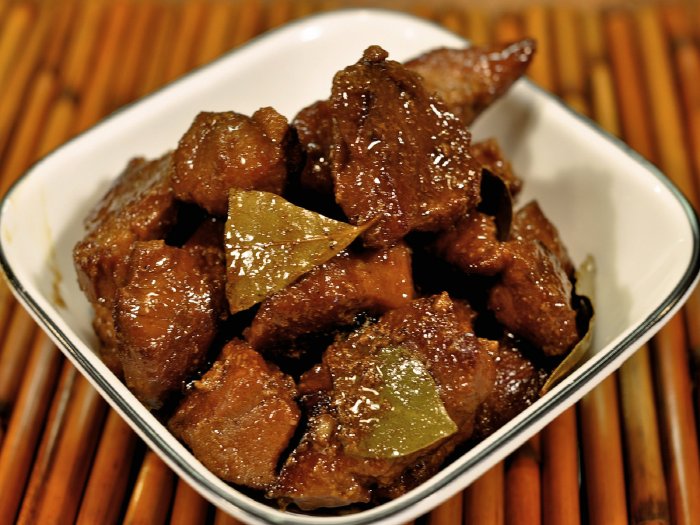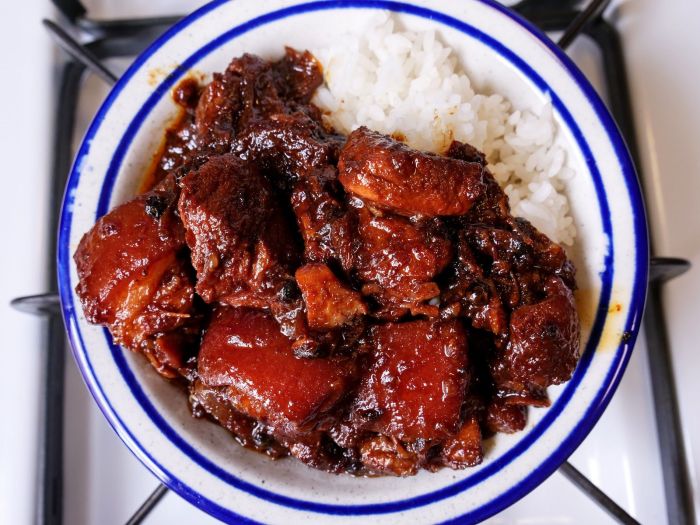Pork adobo recipe is more than just a dish; it’s a cultural icon, a testament to Filipino ingenuity and a culinary masterpiece that has captured hearts and taste buds around the world. This flavorful and versatile dish boasts a rich history, tracing its roots back to the Spanish colonial era.
From its humble beginnings to its modern-day variations, pork adobo has become a symbol of Filipino identity, a dish that brings families and communities together around the table.
The magic of pork adobo lies in its simplicity and its ability to transform ordinary ingredients into an extraordinary culinary experience. The key to a perfect pork adobo lies in the balance of flavors – the tangy vinegar, the savory soy sauce, the aromatic garlic, and the subtle warmth of black peppercorns.
Each ingredient plays a crucial role, contributing to the dish’s signature depth and complexity.
Introduction to Pork Adobo

Pork adobo is a beloved Filipino dish that has become a culinary icon, representing the country’s rich history and diverse culture. This savory and flavorful dish is a testament to the ingenuity and resourcefulness of Filipino cooks who, over centuries, have adapted and perfected this dish, making it a staple in Filipino kitchens and a symbol of Filipino cuisine.
Cultural Significance of Pork Adobo in the Philippines
Pork adobo holds a special place in Filipino culture, transcending its role as a simple dish. It is a dish that evokes nostalgia and a sense of belonging, bringing Filipinos together across generations and geographical boundaries. It is often served at family gatherings, celebrations, and special occasions, symbolizing unity and shared traditions.Pork adobo is deeply ingrained in the Filipino culinary landscape, with variations found in every region of the Philippines.
Each region has its unique twist on the dish, reflecting the local ingredients and cooking techniques, further emphasizing the dish’s cultural significance and adaptability.
Ingredients and Preparation
Pork adobo is a classic Filipino dish known for its savory and tangy flavors. The key to a perfect adobo lies in the balance of ingredients and the careful preparation of the pork.
Ingredients
A simple dish, adobo requires only a few essential ingredients. Here’s a comprehensive list:
- Pork:Pork shoulder, belly, or a combination of both, is traditionally used for adobo. Choose a cut with some fat for flavor and tenderness.
- Vinegar:The type of vinegar used plays a crucial role in the flavor profile of adobo.
- Soy Sauce:Adds saltiness and umami to the dish.
- Garlic:A staple in Filipino cuisine, garlic adds a pungent aroma and flavor to the adobo.
- Black Peppercorns:Enhance the savory notes and add a subtle spice to the dish.
- Bay Leaves:Contribute a fragrant and slightly bitter aroma to the adobo.
- Salt:Adjust to taste, but often, the soy sauce provides enough saltiness.
- Optional Ingredients:Some recipes include additional ingredients like onions, bell peppers, or even a touch of sugar for sweetness.
Vinegar Types and Their Impact on Flavor
The choice of vinegar significantly influences the flavor of adobo.
- Cane Vinegar:A common choice in the Philippines, it has a mild sweetness and a slightly tangy flavor.
- Apple Cider Vinegar:Adds a fruity sweetness and a mellow tang to the dish.
- Rice Vinegar:Offers a subtle sweetness and a slightly acidic flavor.
- White Vinegar:Provides a sharp and acidic tang, which can be too strong for some palates.
Role of Soy Sauce and Other Seasonings
Soy sauce is an essential ingredient in adobo, providing a savory base and adding umami to the dish.
- Soy Sauce:The saltiness of soy sauce balances the acidity of the vinegar, creating a harmonious flavor profile.
- Garlic:Its pungent aroma and flavor complement the savory and tangy notes of the adobo.
- Black Peppercorns:Add a subtle spice and depth of flavor to the dish.
- Bay Leaves:Contribute a fragrant and slightly bitter aroma, enhancing the overall complexity of the adobo.
Preparing the Pork
Proper preparation of the pork is crucial for tender and flavorful adobo.
- Cut the Pork:Cut the pork into bite-sized pieces or leave it whole, depending on your preference.
- Marinate the Pork:Combine the vinegar, soy sauce, garlic, black peppercorns, and bay leaves in a bowl. Add the pork and ensure it’s completely submerged in the marinade. Refrigerate for at least 2 hours, or overnight for optimal flavor.
- Brown the Pork:Heat oil in a large skillet or Dutch oven over medium-high heat. Add the marinated pork and cook until browned on all sides.
Cooking Methods: Pork Adobo Recipe

Pork adobo can be cooked using various methods, each offering unique flavors and textures. The most common methods include stovetop cooking, pressure cooking, and slow cooking.
Stovetop Cooking
This is the traditional method of cooking adobo, and it involves simmering the pork and sauce in a pot on the stovetop. The process allows the flavors to meld and the pork to become tender.
- Steps:
- Brown the pork in a large pot over medium heat. This step helps to develop a rich flavor and color.
- Add the marinade and bring to a boil.
- Reduce heat and simmer until the pork is tender and the sauce has thickened.
- Serve hot over rice.
- Benefits:
- Allows for easy monitoring of the cooking process.
- Provides flexibility in adjusting the sauce consistency.
- Offers a more traditional flavor profile.
- Drawbacks:
- Requires longer cooking time compared to other methods.
- May require frequent stirring to prevent sticking.
Pressure Cooking
Pressure cooking is a faster method that utilizes steam pressure to cook the pork quickly and evenly. This method is particularly useful when time is limited.
- Steps:
- Brown the pork in a pressure cooker over medium heat.
- Add the marinade and bring to a boil.
- Seal the pressure cooker and cook according to the manufacturer’s instructions.
- Release the pressure naturally.
- Serve hot over rice.
- Benefits:
- Reduces cooking time significantly.
- Produces tender pork with a rich flavor.
- Drawbacks:
- May require some adjustments to the recipe to achieve the desired consistency.
- Not suitable for all pressure cookers.
Slow Cooking
Slow cooking is a hands-off method that involves cooking the adobo in a slow cooker for several hours. This method results in a very tender and flavorful pork.
- Steps:
- Brown the pork in a skillet over medium heat.
- Transfer the pork to a slow cooker.
- Add the marinade and cook on low heat for 6-8 hours or on high heat for 3-4 hours.
- Serve hot over rice.
- Benefits:
- Requires minimal supervision.
- Produces incredibly tender pork with a deep flavor.
- Drawbacks:
- May require adjustments to the recipe to achieve the desired sauce consistency.
- Not suitable for all slow cookers.
Cooking Time Comparison
| Cooking Method | Approximate Cooking Time | Result |
|---|---|---|
| Stovetop | 1-2 hours | Tender pork with a rich flavor |
| Pressure Cooker | 30-45 minutes | Tender pork with a rich flavor |
| Slow Cooker | 6-8 hours (low) or 3-4 hours (high) | Very tender pork with a deep flavor |
Variations and Accompaniments
Pork adobo, a beloved Filipino dish, offers a canvas for culinary creativity. Beyond the classic recipe, countless variations and accompaniments enhance its flavor and texture, making it a versatile and adaptable dish.
Variations
The beauty of Pork Adobo lies in its adaptability. Chefs and home cooks alike have experimented with various ingredients, resulting in a diverse array of flavor profiles.
- Chicken Adobo:Replacing pork with chicken is a popular variation. Chicken adobo retains the signature savory and tangy flavors while offering a lighter and leaner protein option.
- Adobo sa Gata (Adobo in Coconut Milk):This variation incorporates coconut milk, lending a creamy and subtly sweet note to the traditional adobo flavors. It often features chicken or pork, along with vegetables like potatoes and bell peppers.
- Adobo sa Puti (White Adobo):This variation uses white wine vinegar instead of the usual cane vinegar, resulting in a lighter and more delicate flavor. It often features pork belly or chicken thighs.
- Adobo with Vegetables:Incorporating vegetables like potatoes, carrots, bell peppers, or green beans adds texture and nutritional value to the dish. The vegetables absorb the adobo flavors, creating a harmonious blend of tastes.
- Spicy Adobo:Adding chili peppers or chili flakes to the adobo marinade infuses the dish with a fiery kick. This variation caters to those who enjoy a spicy touch.
Accompaniments
Pork Adobo is typically served with rice, which absorbs the flavorful sauce and provides a comforting contrast to the rich and savory flavors of the adobo.
- Garlic Fried Rice:This flavorful rice dish, seasoned with garlic and often topped with chopped green onions, complements the adobo’s savory and tangy notes.
- Steamed Vegetables:A simple side of steamed vegetables, such as broccoli, carrots, or green beans, adds freshness and a contrasting texture to the adobo.
Suggested Side Dishes
Beyond the traditional accompaniments, several side dishes can enhance the overall dining experience with Pork Adobo.
- Atchara (Pickled Green Papaya):This tangy and crunchy condiment provides a refreshing contrast to the rich flavors of the adobo.
- Ensalada (Salad):A simple salad with vinaigrette dressing offers a lighter and refreshing element to the meal.
- Pan de Sal (Filipino Bread Rolls):These soft and slightly sweet rolls are ideal for soaking up the adobo sauce.
- Mango Sticky Rice:This sweet and savory dessert, featuring glutinous rice cooked in coconut milk and topped with mangoes, provides a delightful contrast to the savory adobo.
Tips and Tricks

Mastering the art of Pork Adobo is all about achieving that perfect balance of savory, tangy, and slightly sweet flavors. Here are some tips and tricks to help you create an unforgettable dish.
Balancing Flavors
The key to a great Pork Adobo is finding the right balance of ingredients. The acidity of the vinegar and the saltiness of the soy sauce should be balanced by the sweetness of the sugar. Experiment with the ratio of these ingredients to achieve your desired flavor profile.
Obtain access to contoh tips singkat dan menarik to private resources that are additional.
You can also add a touch of citrus, such as calamansi or lemon juice, to brighten the flavors.
Common Mistakes to Avoid
While Adobo is a relatively simple dish to make, there are a few common mistakes to avoid.
Overcooking
Overcooked pork will be dry and tough. Cook the pork until it is just cooked through, and no longer pink.
Not Using Enough Vinegar
The vinegar is what gives Adobo its signature tangy flavor. Don’t be afraid to use enough vinegar to ensure that the pork is well-seasoned.
Not Allowing the Pork to Simmer
Simmering the pork in the Adobo sauce allows the flavors to meld and the pork to become tender. Don’t rush the process.
Storing and Reheating Leftovers, Pork adobo recipe
Adobo tastes even better the next day! Store leftovers in an airtight container in the refrigerator for up to 3 days.
Reheating
You can reheat Adobo on the stovetop over low heat, or in the microwave. If you are reheating on the stovetop, add a little bit of water or broth to prevent the Adobo from becoming too dry.
Adapting for Dietary Restrictions
Gluten-Free
Use gluten-free soy sauce.
Dairy-Free
Adobo is naturally dairy-free.
Vegetarian
You can make a vegetarian version of Adobo by using tofu or tempeh in place of the pork.
Serving and Presentation
Pork Adobo is a dish that is traditionally served with rice, making it a hearty and satisfying meal. It’s also a popular dish to serve during special occasions and gatherings. The simplicity of its preparation and the versatility of its flavors make it a beloved dish in the Philippines.
Traditional Serving
The traditional way of serving Pork Adobo in the Philippines is in a shallow bowl or plate. The meat is usually served with its sauce, and it is often accompanied by steamed rice.
- The sauce is typically thick and flavorful, and it coats the meat well.
- The meat is usually tender and flavorful, and it has a slightly salty and tangy taste.
- The rice is a simple accompaniment that helps to soak up the sauce.
Plating Pork Adobo
A beautifully plated Pork Adobo dish can be a feast for the eyes. Here’s a visual representation:Imagine a white ceramic plate with a small mound of fluffy white rice at the center. On top of the rice, arrange pieces of glistening, golden brown Pork Adobo, their edges slightly caramelized.
The sauce, rich and dark, pools around the meat, creating a glistening pool of flavor. Garnish the dish with a few sprigs of fresh cilantro or a sprinkle of chopped green onions for a touch of color and freshness.
Enhancing Presentation
There are many ways to enhance the presentation of Pork Adobo.
- Garnishes: A sprinkle of chopped green onions, fresh cilantro, or a few slices of red chili pepper can add a touch of color and freshness to the dish.
- Side dishes: Serve Pork Adobo with a side of steamed vegetables, such as green beans, broccoli, or carrots. This will add a touch of color and nutrition to the meal.
- Presentation: Arrange the Pork Adobo on a bed of rice, or use a platter to create a more elegant presentation.
Concluding Remarks
Pork adobo is a culinary journey that takes you through the heart of Filipino culture. Whether you’re a seasoned cook or a culinary novice, this recipe offers a chance to explore the flavors of the Philippines and create a dish that will impress your family and friends.
With its versatility, pork adobo can be adapted to suit any preference, from traditional methods to modern twists. So, embrace the adventure, gather your ingredients, and let the aroma of pork adobo fill your kitchen with the warmth and hospitality of the Philippines.
